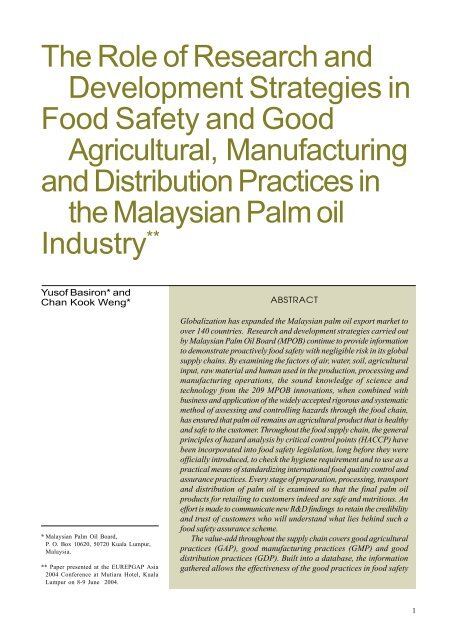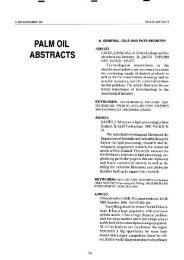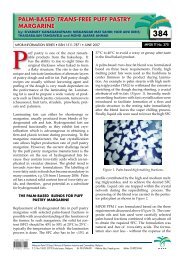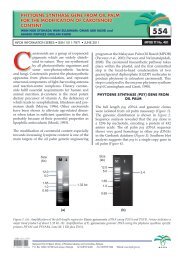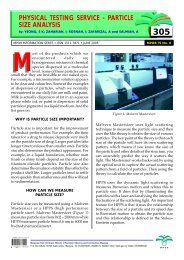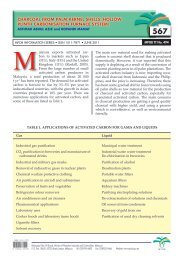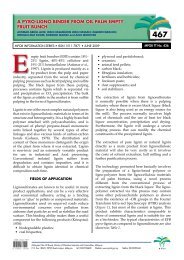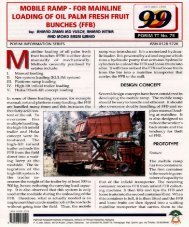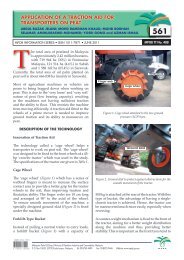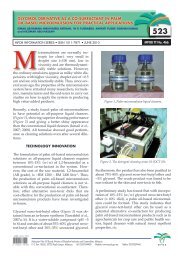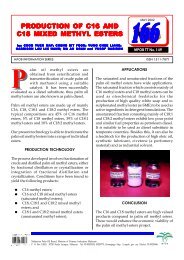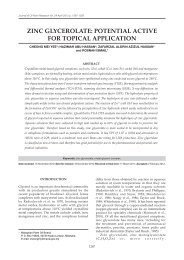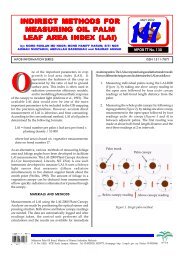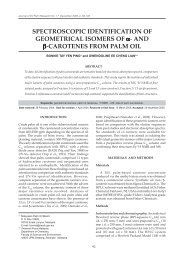Download PDF - PALMOILIS - MPOB
Download PDF - PALMOILIS - MPOB
Download PDF - PALMOILIS - MPOB
You also want an ePaper? Increase the reach of your titles
YUMPU automatically turns print PDFs into web optimized ePapers that Google loves.
THE ROLE OF RESEARCH AND DEVELOPMENT STRATEGIES IN FOOD SAFETY AND GOOD AGRICULTURAL, MANUFACTURING<br />
AND DISTRIBUTION PRACTICES IN THE MALAYSIAN PALM OIL INDUSTRY<br />
The Role of Research and<br />
Development Strategies in<br />
Food Safety and Good<br />
Agricultural, Manufacturing<br />
and Distribution Practices in<br />
the Malaysian Palm oil<br />
Industry **<br />
Yusof Basiron* and<br />
Chan Kook Weng*<br />
* Malaysian Palm Oil Board,<br />
P. O. Box 10620, 50720 Kuala Lumpur,<br />
Malaysia.<br />
** Paper presented at the EUREPGAP Asia<br />
2004 Conference at Mutiara Hotel, Kuala<br />
Lumpur on 8-9 June 2004.<br />
ABSTRACT<br />
Globalization has expanded the Malaysian palm oil export market to<br />
over 140 countries. Research and development strategies carried out<br />
by Malaysian Palm Oil Board (<strong>MPOB</strong>) continue to provide information<br />
to demonstrate proactively food safety with negligible risk in its global<br />
supply chains. By examining the factors of air, water, soil, agricultural<br />
input, raw material and human used in the production, processing and<br />
manufacturing operations, the sound knowledge of science and<br />
technology from the 209 <strong>MPOB</strong> innovations, when combined with<br />
business and application of the widely accepted rigorous and systematic<br />
method of assessing and controlling hazards through the food chain,<br />
has ensured that palm oil remains an agricultural product that is healthy<br />
and safe to the customer. Throughout the food supply chain, the general<br />
principles of hazard analysis by critical control points (HACCP) have<br />
been incorporated into food safety legislation, long before they were<br />
officially introduced, to check the hygiene requirement and to use as a<br />
practical means of standardizing international food quality control and<br />
assurance practices. Every stage of preparation, processing, transport<br />
and distribution of palm oil is examined so that the final palm oil<br />
products for retailing to customers indeed are safe and nutritious. An<br />
effort is made to communicate new R&D findings to retain the credibility<br />
and trust of customers who will understand what lies behind such a<br />
food safety assurance scheme.<br />
The value-add throughout the supply chain covers good agricultural<br />
practices (GAP), good manufacturing practices (GMP) and good<br />
distribution practices (GDP). Built into a database, the information<br />
gathered allows the effectiveness of the good practices in food safety<br />
1
OIL PALM INDUSTRY ECONOMIC JOURNAL (VOL. 5(1)/2005)<br />
2<br />
management, detection of contaminants, toxicology, novel processing,<br />
packaging and application of risk management to be evaluated. The<br />
harmonization of these good practices towards standardization provides<br />
a high level of confidence to the operational entities and the customers.<br />
The auditors and assessors when benchmarked by accredited bodies<br />
that are internationally recognized, the industry will attain integrity<br />
by their assessment. Knowledge that Malaysian palm oil products are<br />
produced to an agreed standard will further boost consumer confidence<br />
by making them even more acceptable by people the world over.<br />
INTRODUCTION<br />
The Malaysian palm oil business<br />
has over nearly a century and a half<br />
of growth. The oil palm,<br />
introduced to Malaysia (Malaya<br />
then) in 1870, is today a<br />
multibillion-ringgit industry. Palm<br />
oil is exported to over 140<br />
countries. Throughout the past<br />
150 years, the impact of R&D<br />
strategies and policies on the<br />
industry has been one of<br />
continuous strengthening of the<br />
industry through the application of<br />
good science and technology. In<br />
particular over the past 25 years,<br />
the Malaysian Palm Oil Board<br />
through the merger of its fore<br />
runners, the Palm Oil Research<br />
Institute of Malaysia (PORIM) and<br />
Palm Oil Registration and<br />
Licensing Authority (PORLA) has<br />
accomplished much. Working<br />
closely with the industry members,<br />
<strong>MPOB</strong> R&D findings have helped<br />
to raise palm oil production from<br />
2.5 million tonnes in 1979 to 13.5<br />
million tonnes in 2003, an<br />
expansion feat unparalleled in<br />
history. The capability of the<br />
industry also expanded with<br />
employment of over 1.399 million<br />
people working in its 3.804 million<br />
hectares of oil palm, 370 mills, 47<br />
refineries, 39 kernel crushing<br />
plants, 17 oleochemical plants and<br />
33 bulking installations at the end<br />
of 2003 (<strong>MPOB</strong>, 2004a).<br />
Starting with a humble<br />
beginning of about 38 thousand<br />
(K) hectares in 1950, the growth<br />
in planted area in each decade had<br />
been phenomenal. Initially, the<br />
increases were small at 54.6K ha<br />
in the 1960s and 261.4K in the<br />
1970s, but thereafter the growth<br />
was tremendous with the area<br />
reaching 1023.0K ha in 1980s and<br />
2029.5K ha in the 1990s. Since<br />
then, the area has reached 3067.4K<br />
ha in the 2000s with the area at<br />
end of 2003 standing at 3.80<br />
million hectares. Over the past six<br />
years from 1998 to 2003, after the<br />
Asian financial crisis in 1997, the<br />
industry had performed well and<br />
earned foreign exchange of RM<br />
22.6, 19.2, 14.9, 14.1, 19.6 and<br />
26.5 billion in each of years<br />
respectively. By end 2003, the<br />
Malaysian oil palm industry had<br />
indeed flourished under a tight<br />
world oils and fats supply<br />
situation.<br />
The 2003 production of crude<br />
palm oil (CPO) rose by 12.1% to<br />
13.35 million tonnes from 11.91<br />
million tonnes in 2002. The<br />
production of crude kernel oil also<br />
increased from 1.47 to 1.64 million<br />
tonnes (<strong>MPOB</strong>, 2004b). The<br />
exports of CPO and crude kernel<br />
oil were 12.248 and 0.870 million<br />
tonnes respectively. Besides CPO<br />
and crude kernel oil, palm kernel<br />
cake at 1.910 million tonnes and<br />
oleochemical products at 1.801<br />
million tonnes were also exported.<br />
The average price of palm oil<br />
strengthened in 2003 to an average<br />
CPO price of RM 1544/t, an<br />
increase from RM 1363/t in 2002.<br />
It is heartening to note that the
THE ROLE OF RESEARCH AND DEVELOPMENT STRATEGIES IN FOOD SAFETY AND GOOD AGRICULTURAL, MANUFACTURING<br />
AND DISTRIBUTION PRACTICES IN THE MALAYSIAN PALM OIL INDUSTRY<br />
massive increase in production was<br />
supported by an increase in the<br />
price. Of the export, 90% was used<br />
as food and 10% for oleochemicals.<br />
Based on the 2003 performance,<br />
the production growth in 2004 for<br />
palm oil is expected to be lower<br />
because of its cyclical nature.<br />
However, the oil palm industry in<br />
2004 is forecast to remain bullish<br />
(Yusof, 2004).<br />
STRATEGIES<br />
The transformation of the oil palm<br />
industry to its present diversified<br />
industry has been due to good<br />
R&D support and government<br />
policies, such as the Agricultural<br />
Diversification Policy in the 1960s<br />
which shifted from rubber to oil<br />
palm. This was followed by the<br />
land settlement schemes<br />
spearheaded by the Federal Land<br />
Development Authority (FELDA).<br />
Subsequently with the large supply<br />
of palm oil, other strategies were<br />
implemented with the<br />
establishment of kernel crushing<br />
facilities, refineries and<br />
oleochemical plants. This<br />
stimulated the growth of<br />
downstream products with valueadded<br />
for the commodity being<br />
exported. Yet another success<br />
factor is the research cess that<br />
allows the industry to fund R&D<br />
to enhance its progress. The cess<br />
also funds the Malaysian Palm Oil<br />
Promotion Council (MPOPC). All<br />
these strategies have enabled the<br />
industry to deliver high quality<br />
products competitively. The<br />
Malaysian palm oil industry indeed<br />
is truly one of the best organized<br />
for any internationally commodity.<br />
Promotion has allowed<br />
worldwide acceptance of palm oil<br />
which is continuously enhanced by<br />
R&D. Quality assurance efforts<br />
have developed trade specifications<br />
for palm oil products which has<br />
facilitated market development.<br />
The set properties of palm oil have<br />
enable preparation of standards for<br />
the Codex Alimentarius. The<br />
industry has branched out into<br />
three major areas in the food sector,<br />
non-food or oleochemicals sector<br />
and biomass and fibre-composite<br />
sector. The latest strategy is to<br />
produce carbon credit by carbon<br />
dioxide sequestration to reduce<br />
greenhouse gas emissions.<br />
To sustain such a large palm oil<br />
production, R&D is the key to<br />
continuously improve competitiveness,<br />
increase profits and gain market<br />
share (Yusof and Chan, 2003).<br />
The palm oil industry is no<br />
stranger to using R&D to improve<br />
its competitiveness, especially food<br />
safety. The issue of food safety is<br />
not new. Green consumerism and<br />
greening of the supply chain are<br />
increasing what the NGOs want.<br />
The recent call to consider the<br />
EUREPGAP protocol allows<br />
Malaysia to review in repackage of<br />
good practices used. EUREP stands<br />
for Euro Retailer Produce and GAP<br />
for Good Agricultural Practice. It<br />
is primarily targeted for a limited<br />
sector of fresh produce, flowers,<br />
livestock grains and feeds. With<br />
strong traditions of R&D, the<br />
Malaysian oil palm industry is in<br />
an even better position to produce<br />
good palm oil products for<br />
European Union (EU). As the<br />
ability to offer safe and nutritious<br />
foods improves further, higher<br />
prices can be justified with the<br />
higher margins and profits.<br />
Consumers will pay a premium for<br />
foods that taste better are more<br />
nutritious, healthier and safer.<br />
Thus, the aim of this paper is<br />
to demonstrate the role of R&D in<br />
maintaining the food safety of palm<br />
oil by providing an understanding<br />
of the structural relationship<br />
between food production and the<br />
environment, humans, physical<br />
and regulatory systems and<br />
institutions.<br />
AWARENESS OF FOOD<br />
SAFETY IN THE CONTEXT OF<br />
THE OIL PALM INDUSTRY<br />
The industry is fully aware of the<br />
scrutiny palm oil, as a food is<br />
subjected to by regulatory systems<br />
and institutions. In palm oil<br />
production, therefore, food safety<br />
must be a priority.<br />
All countries must have a Food<br />
and Drug Act or its equivalent to<br />
improve food safety and nutritional<br />
quality. This has prompted most<br />
governments today to establish an<br />
agency to enforce food standards.<br />
Some examples of such agencies<br />
are the Food and Drugs Agency<br />
(FDA) in the United States, Food<br />
Standards Agency (FSA) in the<br />
United Kingdom, Canadian Food<br />
Inspection Agency (CFIA), India’s<br />
Central Committee for Food<br />
Standards (CCFS), Japan’s Ministry<br />
of Agriculture, Fisheries and<br />
Forestry (MAFF) and European<br />
Food Safety Authority (EFSA). All<br />
these agencies serve similar<br />
functions within their respective<br />
jurisdictions.<br />
There is also, under the banner of<br />
the Joint Food and Agriculture and<br />
World Health Organization (FAO/<br />
WHO) Food Standard Programme,<br />
the Codex Alimentarius Commission<br />
(CAC) which several committees<br />
provides a global discussions on<br />
various aspects of food, including<br />
safety and labelling practices.<br />
Malaysia is a party to the<br />
negotiations. As the CAC and its<br />
subcommittees have no mandatory<br />
powers, the responsibility resides<br />
in the individual governments’<br />
food safety agencies to enforce.<br />
Particular attention is paid to<br />
the ingredients and the nutritional<br />
qualities that need legal<br />
compliance by the appropriate<br />
government regulators. There is a<br />
need to provide the right type of<br />
information, based on the<br />
consumer’s rights to know, to be<br />
3
OIL PALM INDUSTRY ECONOMIC JOURNAL (VOL. 5(1)/2005)<br />
able to choose food that is safe and<br />
nutritious. It is with this premise<br />
that the following section is written<br />
to inform the consumer of the<br />
R&D input to ensure the safety of<br />
palm oil and its products.<br />
4<br />
ASSURING FOOD SAFETY OF<br />
PALM OIL THROUGH<br />
CURRENT R&D STRATEGIES<br />
The objective here is to inform the<br />
participants of the role played by<br />
<strong>MPOB</strong> in palm oil safety. There are<br />
two major requirements:<br />
⇑ the first requirement is that<br />
the market has invariably<br />
combined food safety with<br />
eight other issues viz.<br />
human food need, public<br />
health, nutraceuticals/<br />
functional, pharmaceuticals,<br />
nutrition, biotechnology,<br />
ecology and sustainability,<br />
and governance; and<br />
⇑ the next requirement is for<br />
<strong>MPOB</strong> to take a proactive<br />
approach in tackling these<br />
eight issues simultaneously.<br />
By doing so, it will allow the<br />
industry to benefit from its<br />
R&D which must ensure<br />
negligible risk throughout<br />
the value-added supply<br />
chain so that palm oil<br />
remains an agricultural<br />
product that is healthy,<br />
nutritious and safe to the<br />
customer.<br />
These requirements are<br />
achieved through productive<br />
dialogues and collaboration in<br />
surveys carried out by <strong>MPOB</strong>. They<br />
offer valuable market feedbacks<br />
from the various stakeholders and<br />
consumers for incorporation in<br />
R&D programmes in <strong>MPOB</strong>.<br />
Meeting the Need for Palm Oil as<br />
Human Food<br />
Although Malaysian palm oil is<br />
exported to over 140 countries, the<br />
bulk is exported to only four<br />
countries/region. China, India and<br />
Pakistan in Asia which respectively<br />
took 2.546, 1.594, 1.099 million<br />
tonnes, and the EU, as a region,<br />
which took 1.695 million tonnes.<br />
Palm oil is attractive to the<br />
developing countries because it is<br />
usually cheaper than the other<br />
imported oils and fats and this has<br />
been a significant feature in<br />
increasing palm oil consumption in<br />
these countries. There has been a<br />
smear campaign on the health<br />
attributes of palm oil by other<br />
oilseed competitors. But palm oil<br />
is not detrimental to health, and<br />
the developing countries are aware<br />
of this. But very soon the<br />
consumers will all be demanding<br />
the same food safety and<br />
nutritional standards as the<br />
developed countries. The industry<br />
has to be prepared for this.<br />
Meeting Palm Oil as a Health Food<br />
Palm oil contains roughly equal<br />
amounts of saturated (mainly<br />
palmitic) and unsaturated acids<br />
(mainly oleic) and is a valuable<br />
source of carotenes and tocopherols/<br />
tocotrienols. Particularly in the<br />
advanced and emerging economies,<br />
the change in life style resulting from<br />
living in large cities has led the<br />
people to functional foods with<br />
health and disease prevention<br />
claims. R&D, for example, has<br />
shown that palm oil can be a good<br />
partner in the current dietary fat<br />
recommendation for many foods.<br />
This has led <strong>MPOB</strong> to launch a<br />
patented health margarine called<br />
Smart Balance. Basically, the<br />
product balances the lipoprotein<br />
cholesterol in humans. Today, the<br />
world is also looking increasingly<br />
at palm oil to avoid trans fatty acids<br />
in foods since palm oil with its<br />
natural saturated palmitic acid is<br />
the natural choice for many of the<br />
food formulations. The palm oil<br />
margarine available in the market<br />
today has the body and texture that<br />
do not need modification of the oil<br />
by hydrogenation unlike that of<br />
oilseeds. Palm oil therefore<br />
provides a trans-free choice of<br />
margarine for the consumer.<br />
Meeting Palm Oil as a Functional/<br />
Nutraceutical Food<br />
The interest in diet and health<br />
has spawned a whole new food<br />
requirement since the 1990s<br />
functional/nutraceutical and<br />
pharmaceutical benefits of palm oil<br />
that collectively are referred to as<br />
functional foods. Functional food<br />
is a broad category encompassing<br />
nutraceuticals, designer foods,<br />
medical foods, pharmafoods and<br />
phytochemicals. The functional/<br />
nutraceutical market was estimated<br />
to be USD 80 billion in 1998 but is<br />
set to grow to USD 5000 billion by<br />
2010 (Stuart, 1998).<br />
Meeting Palm Oil as a Base for<br />
Pharmaceuticals<br />
There are also other trends<br />
where vitamins and supplements<br />
together are now the 10 th largest<br />
category across all food, drug and<br />
mass merchandizing outlets.<br />
Herbal sales are growing and it was<br />
estimated to be USD 5 billion in<br />
2000 (American Botanical Council,<br />
1995). Again thanks to R&D<br />
strategies, inroads have been made<br />
into this health arena of food by<br />
palm oil. Already there have been<br />
successful launchings of vitamin E<br />
and red palm oil technologies. Both<br />
have strengthened palm oil’s grip on<br />
the niche market in health food. For<br />
example, vitamin E tocotrienols are<br />
the current trendsetter in fat soluble<br />
antioxidants. Further, palm oil<br />
tocotriennols with antioxidant<br />
effects, cholesterol lowering<br />
properties and possible anti-cancer<br />
properties are emerging market<br />
leaders and their claims are being<br />
researched widely in clinical trials<br />
to confirm the results. Already, red
THE ROLE OF RESEARCH AND DEVELOPMENT STRATEGIES IN FOOD SAFETY AND GOOD AGRICULTURAL, MANUFACTURING<br />
AND DISTRIBUTION PRACTICES IN THE MALAYSIAN PALM OIL INDUSTRY<br />
palm oil technology is a process<br />
that retains the pro-vitamin A<br />
carotenoids in the oil. This has<br />
already become Malaysia’s gift to<br />
the children of the world simply<br />
because its consumption can<br />
restore the vision of children and<br />
reduce the risk of children going<br />
blind due to vitamin A deficiency.<br />
Meeting Research in Biotechnology<br />
and Genetically Modified Foods<br />
Currently, palm oil is<br />
completely GM-free and the<br />
industry is strategically exploiting<br />
this fact to Malaysia’s advantage<br />
given that a large proportion of the<br />
soyabean produced in the world<br />
today is genetically modified.<br />
Biotechnology, however, as a<br />
powerful tool, which should not be<br />
overlooked in view of the potential<br />
benefit it has for the betterment of<br />
the oil palm industry.<br />
This high growth area has<br />
allowed the impact of biotechnology<br />
in manipulating plants to express<br />
their properties in their<br />
compositional changes to result in<br />
improved oils and even proteins for<br />
the food market in the future. This<br />
will advance our competitiveness<br />
even further as we move away from<br />
the traditional uses. The trend has<br />
been such that initially palm oil is<br />
widely used as a cooking and<br />
frying oil, in spreads and in<br />
shortening and as a salad oil. Next,<br />
with fractionation, palm oil<br />
extended its use as palm olein,<br />
palm stearin and palm mid<br />
fraction. Now it appears that like<br />
many other major crops in<br />
competing with palm oil, they had<br />
to resort to biotechnology to<br />
improve their competitiveness.<br />
These oilseeds do eventually have<br />
some transgenic products in them.<br />
In the future, as the food<br />
processing industry learns to deal<br />
with the many possibilities for<br />
nutrient or phytochemical<br />
modifications that occur in<br />
genetically modified food, oil palm<br />
R&D through biotechnology will<br />
have to be in a position in the<br />
future to provide a strong base for<br />
producing a whole spectrum of<br />
high-value food products through<br />
genetic engineering which<br />
increasingly will be given<br />
emphasis. Food safety must<br />
invariably be linked to<br />
biotechnology in the future to<br />
produce tailored oils for niche<br />
markets. Although the initial R&D<br />
efforts in oil palm have been<br />
dealing with the genes of resistance<br />
to weeds and diseases, the next<br />
wave will see compositional<br />
changes with improved oils and<br />
proteins.<br />
Meeting Ecology and Sustainability<br />
of Food Production<br />
The urgency of increasing palm<br />
oil for food production should not<br />
be underestimated. Over the past<br />
decade, the average yield of<br />
Malaysian palm oil has stagnated<br />
at 3.5-3.8 t/ha although some<br />
plantations achieve much higher<br />
yields. One factor for the yield<br />
stagnation is the low replanting<br />
rate coupled with low uptake rate<br />
of new higher quality germplasm<br />
that can yield as much as 7.5 t/ha,<br />
i.e. double the current yield.<br />
Doubling the yield would bring in<br />
revenue of another RM 4 billion<br />
(Murphy, 2003). It is vitally<br />
important to ensure that the R&D<br />
strategies to increase productivity<br />
on the short-term can be sustained<br />
and effectively integrated with the<br />
long-term policies. Luckily, the<br />
<strong>MPOB</strong> strategy to increase palm oil<br />
production on a sustained basis<br />
has always taken the environment<br />
into account. The advances have<br />
been incorporated into the GAP<br />
and GMP.<br />
There is avoidance of<br />
environmental pollution. At the<br />
same time, by ensuring that in the<br />
development process emphasis is<br />
on the maintenance of the<br />
productive capacity of the basic<br />
natural resources of food and<br />
agriculture, the sustainable<br />
practices are enhanced. This<br />
includes use of biopesticides like<br />
Metarhizzium fungus and virus for<br />
rhinoceros beetles and grubs, Bts<br />
for bagworms, integrated pest<br />
management like barn owls against<br />
rats and planting of beneficial<br />
plants to increase the number of<br />
predators thereby reducing the use<br />
of chemical pesticides in the long<br />
run.<br />
There is also reduction in the<br />
use of chemical fertilizers through<br />
recycling by empty fruit bunches,<br />
effluent, frond mulching and<br />
planting of legumes during the<br />
immature period. The ecology of the<br />
oil palm plantation is well taken care<br />
of. In fact, technology transfers have<br />
been successful because of the<br />
proper consideration of the social,<br />
cultural, educational, economical<br />
and ecological conditions of the<br />
local regions. The latest technologies<br />
are always adjusted to the local<br />
conditions to the highest degree so<br />
as to gain wide implementation.<br />
While not forgetting to raise<br />
productivity per hectare, the<br />
planters need to be good<br />
conversationalists by working<br />
closely with the NGOs to achieve<br />
the common goal of sustainable<br />
development with biological<br />
diversity preservation and good<br />
stewardship of the environment.<br />
The reduction of use of herbicides<br />
and pesticides during production<br />
will auger well for preservation of the<br />
environment and improving the food<br />
safety of palm oil. One such effort to<br />
communicate the good result to the<br />
retailers is the Round Table of<br />
Sustainable Palm Oil (RSPO)<br />
negotiations between the producers,<br />
retailers with participation by the<br />
NGOs.<br />
5
OIL PALM INDUSTRY ECONOMIC JOURNAL (VOL. 5(1)/2005)<br />
Meeting Good Governance<br />
Requirement<br />
Finally, as food moves through<br />
the system from the producer to the<br />
consumer, there must be put in place<br />
good governance. There are different<br />
sets of regulations, standards and<br />
policies to ideally ensure palm oil<br />
food safety and nutritional quality.<br />
However, as different departments of<br />
the government are involved in<br />
policy making, e.g. transport,<br />
customs and excise and police, there<br />
must be good cooperation between<br />
the departments to overcome<br />
inadequacies and for better<br />
enforcement.<br />
Though palm oil is GM-free, a<br />
good example of the legislation<br />
required may be cited from the<br />
oilseed producers that have<br />
resorted to use GM technology to<br />
compete with palm oil. The<br />
legislation passed by the European<br />
Parliament concerning the<br />
production of GM crops in the area<br />
of biotechnology requires the need<br />
to show a general obligation for<br />
labelling and traceability on the<br />
part of the suppliers over the entire<br />
chain. The main provisions are:<br />
6<br />
i) all GM foods and<br />
ingredients of human foods<br />
and animal feed are to be<br />
labelled;<br />
ii) in refined ingredients, there<br />
should not be any trace of<br />
transgenic DNA or protein<br />
detectable in oils, starch<br />
and lecithin;<br />
iii) full traceability is required<br />
to demonstrate that that<br />
the source is not GM and<br />
that the produce had been<br />
effectively segregated at all<br />
stages;<br />
iv) even when item (iii) has<br />
been met but with<br />
technically unavoidable<br />
mixing with detectable<br />
amounts of GM material,<br />
the GM level is now set at<br />
0.9 %; and.<br />
v) a special allowance has<br />
been introduced to permit<br />
up to 0.5% of unapproved<br />
GM to appear in legally<br />
imported materials.<br />
GOOD AGRICULTURAL<br />
PRACTICES (GAP), GOOD<br />
MANUFACTURING<br />
PRACTICES (GMP) AND<br />
GOOD DISTRIBUTION<br />
PRACTICES (GDP)<br />
The field, milling, refining and<br />
transport practices contributing to<br />
improvement of quality of palm oil<br />
have also been supported by<br />
advances in knowledge and<br />
equipment of storage, handling<br />
and transportation to improve the<br />
palm oil and kernel oil quality and<br />
preservation of the refined oil<br />
quality. The various best practices<br />
have been incorporated into the<br />
GAP, GMP and GDP. As a result of<br />
the GAP, GMP and GDP being in<br />
place, many plantations, mills and<br />
refineries, some since the 1980s,<br />
have qualified for the competency<br />
certification awards by <strong>MPOB</strong> - the<br />
oil palm nursery competency<br />
certificate (OPNCC), the mill<br />
competency certificate (MCC) and<br />
refinery certificate of competency<br />
(RCOC).<br />
The competency certification<br />
efforts from nursery to mills and<br />
refineries reflected <strong>MPOB</strong>’s early<br />
emphasis on hygiene and food<br />
safety and quality over the entire<br />
food supply chain. The industry,<br />
spurred by the R&D innovations,<br />
had also an early start in quality<br />
assurance in food safety, long<br />
before the west introduced HACCP.<br />
Now with the impending<br />
consideration of the EUREPGAP<br />
requirements, it is time to review<br />
the quality standards in existence.<br />
As palm oil is a late comer to the<br />
oils and fats scene, the persistent<br />
efforts in promoting its hygiene,<br />
technical and nutritional attributes<br />
have been successful in convincing<br />
many new users that palm oil<br />
production is hygienic, its products<br />
versatile and consumption<br />
wholesome, thereby opening up<br />
many new markets. For example,<br />
some recent figures on the<br />
competency certificates for the<br />
nurseries are shown in Table 1.<br />
As for 2004, it is intended that<br />
instead of the current voluntary<br />
submission of nurseries by their<br />
owners for inspection and<br />
certification, there will be 100%<br />
inspection of all nurseries in the<br />
future. The guidelines on the<br />
marking scheme for the certificate<br />
of competency for nurseries and<br />
the marking forms for the nursery<br />
inspection are extended to the<br />
nurseries and agreed upon by all<br />
the participating nurseries before<br />
the marking is done.<br />
As for the milling certificate of<br />
competency (MCC), the scheme<br />
was started in 1984 by the<br />
Chemistry and Technology<br />
Division, PORIM. The number of<br />
mills certified to date is 200 but the<br />
actual existing mills in the scheme<br />
TABLE 1. OIL PALM NURSERY COMPETENCY CERTIFICATES<br />
(OPNCC) AWARDED<br />
Year No. No. No. %<br />
licenced visited certificates<br />
issued<br />
Awarded<br />
2001 377 55 48 87.3<br />
2002 357 65 47 72.3<br />
2003 358 38 33 86.8<br />
2004* 345 30 11 36.7<br />
Note: *Certification as at 30 April 2004.<br />
Source: Zulklifi Abdul Manap (per. comm., 2004).
THE ROLE OF RESEARCH AND DEVELOPMENT STRATEGIES IN FOOD SAFETY AND GOOD AGRICULTURAL, MANUFACTURING<br />
AND DISTRIBUTION PRACTICES IN THE MALAYSIAN PALM OIL INDUSTRY<br />
as of May 2004 has only 187 (Choo<br />
Yuen May, per. comm., 2004). This<br />
is because over the years since the<br />
scheme was started, some mills<br />
have closed down or changed their<br />
management and subsequently<br />
dropped out. This gives about<br />
50.5% of the voluntary mills<br />
covered out of the 370 mills in<br />
operation. Again the guidelines<br />
covering the marking scheme for<br />
the certificate of competency of<br />
palm oil mills (PORIM, 1990),<br />
together with the framework of the<br />
marking scheme for the mill<br />
inspection (PORIM, 1989), are<br />
extended to the mills before the<br />
inspection is done. Again the<br />
intention is to go for 100%<br />
inspection of all the mills in the<br />
future.<br />
As for the refinery certificate of<br />
competency (RCOC), the<br />
percentage of refineries qualifying<br />
for the competency certificates is<br />
shown in Table 2.<br />
Since the inception, it can be<br />
seen from Table 2 that over the<br />
years, new parameters and<br />
analytical methods to better help<br />
characterize the oil and its quality<br />
has been introduced. Regular<br />
checks were carried out by the<br />
Enforcement and Licensing<br />
Division to ensure that the quality<br />
of the finished oil during storage,<br />
transport and shipments complies<br />
with the relevant quality<br />
specification. From the beginning,<br />
the RCOC has also been reviewed<br />
four times (Tang and Johari, 2002)<br />
with new audit areas added at each<br />
review, e.g. ISO 9000, HACCP and<br />
other accreditations such as OSHA.<br />
GMP and ISO 14001. HACCP<br />
indicates that the refineries are<br />
committed to food safety.<br />
It is important to mention here<br />
that there is also 100% sampling<br />
and analysis of all Malaysian palm<br />
oil exported to Europe as our<br />
added assurance.<br />
The importance of good quality<br />
palm oil is imperative for the good<br />
long-term stability of the refined oil<br />
that, in turn, will affect its usage<br />
in downstream/finished products.<br />
It goes without saying that palm oil<br />
quality is made in the field and the<br />
milling and processing, and the<br />
refining only helps to maintain it.<br />
Thus, improper handling of fresh<br />
fruit bunch (FFB) in the field,<br />
incomplete collection of loose<br />
fruits, delay in processing and<br />
improper handling, storage and<br />
transportation only serve to cause<br />
quality deterioration and<br />
TABLE 2. REFINERY CERTIFICATE OF COMPETENCY (RCOC)<br />
SINCE INCEPTION IN 1984<br />
Year No. % Year No. %<br />
refineries Awarded refineries Awarded<br />
1984 19 78.9 1992 21 88.6<br />
1985 21 79.9 1993 20 84.6<br />
1986 25 80.4 1994 25 80.3a 1987 25 82.2 1995b 25 81.5<br />
1988 25 82.7a 1996/7c 27 81.5<br />
1989 24 86.0 1998/9c 30 81.9<br />
1990 25 86.4 2000/1ce 28 79.6<br />
1991 26 87.4 2002/3c 31 85.0<br />
2004/5e 31 86.7<br />
Notes: a Reviewed and tightened marking scheme used.<br />
b ISO 9000 elements introduced.<br />
c Biennial inspection for those with scores of 70% and above.<br />
d Deferred as companies were shifting location or under renovation.<br />
e Elements of HACCP introduced.<br />
Source: Tang Thin Sue and Rozita Baharuddin (per. comm., 2004).<br />
sometimes the deterioration is<br />
caused by contamination of some<br />
foreign materials unintentionally.<br />
STRENGTHENING<br />
PARTNERSHIPS IN FOOD<br />
SAFETY: INTERFACE<br />
BETWEEN PLAYERS AND<br />
SCIENTISTS IN THE FOOD<br />
CHAIN<br />
Certainly, in today’s communication<br />
age, news spreads instantaneously<br />
across to the customer. Therefore,<br />
the industry, through its supply<br />
chain, needs to be fully aware of the<br />
happenings and provide accurate<br />
facts to assure the food safety of the<br />
palm oil products. Eight major<br />
requirements call for a plantation<br />
business enterprise to go beyond<br />
striving for greater efficiency alone<br />
when producing palm oil from the<br />
food safety aspect.<br />
From the brief summaries of the<br />
eight requirements, the industry<br />
seems to be doing well thus far. We<br />
must not allow yesterday’s success<br />
to lull us into today’s complacency,<br />
for this is the great foundation of<br />
failure. We should subject<br />
ourselves to some sort of selfexamination<br />
and this is a<br />
compelling factor to take this<br />
seminar as an opportunity to view<br />
new vistas in the food safety<br />
aspects in food production. From<br />
the eight issues summarized, there<br />
is a combined shift that points to<br />
three considerations that will drive<br />
the food safety business of the<br />
plantation company. They are:<br />
⇑ firstly, palm oil has to be<br />
people- and health/safety<br />
food product-oriented;<br />
⇑ secondly, palm oil must meet<br />
international demand; and<br />
⇑ thirdly, palm oil must exhibit<br />
long-term thinking behind<br />
R&D.<br />
7
OIL PALM INDUSTRY ECONOMIC JOURNAL (VOL. 5(1)/2005)<br />
People- and Health/Safety Food<br />
Product-Oriented<br />
The basis for linking R&D to<br />
the food chain is the Farm-to-Table<br />
concept. Quality is the priority of<br />
the food chain and there are three<br />
dimensions:<br />
8<br />
⇑ social: affordable, convenience,<br />
easily available at retail<br />
stores, acceptable to all<br />
cultural and ethnic<br />
backgrounds, participation<br />
by the community and<br />
preservation of the environment;<br />
⇑ health: related to nutritional<br />
and safety; and<br />
⇑ economical: related to price<br />
performance.<br />
R&D is the cornerstone to the<br />
palm oil assurance on quality.<br />
Currently, <strong>MPOB</strong> has 1300 staff<br />
spread worldwide and the R&D<br />
network examines the functional<br />
areas over the value supply chain<br />
as outlined in Figure 1. From Figure<br />
1, the history of palm oil from<br />
production, processing manufacturing,<br />
distribution and transport will<br />
acquire positive and negative<br />
attributes as it moves along the<br />
chain. The elements of undesirable<br />
contamination can be introduced<br />
with the agricultural inputs, such<br />
as seeds, fertilizers, herbicides,<br />
pesticides and other chemicals<br />
from production practices,<br />
processing, manufacturing,<br />
distribution and transport. Besides<br />
the agricultural inputs, other<br />
sources of contamination can come<br />
about through recycling, or<br />
indirectly from natural resources<br />
like air, water and soil pollution.<br />
Some sources of contamination<br />
such as air pollution from<br />
industrialized activity can be<br />
carried over long distances through<br />
air circulation to other parts where<br />
they precipitate and contaminate<br />
the natural environment and enter<br />
the food chain.<br />
Figure 1. Schematic representation of food chain<br />
A case in point is the persistent<br />
organic pollutants (POPs). In the<br />
Stockholm Convention on POPs,<br />
there are 12 POPs of which nine,<br />
viz., Aldrin, Chlordane, DDT,<br />
Dieldrin, Endrin, Heptachlor, Mirex<br />
and Toxaphene, are pesticides; two,<br />
viz., Hexachlorobenzene and<br />
polychlorinated biphenyls (PCBs),<br />
industrial chemicals and the<br />
remaining two, i.e. Dioxins and<br />
Furans, by-products of burning<br />
and combustion. Luckily in<br />
Malaysia, all the nine pesticides<br />
have been banned. Under the<br />
Stockholm Convention of POPs,<br />
the intentional production of the<br />
dirty dozen (of chemicals) will be<br />
eliminated except for the special<br />
public register of DDT for disease<br />
vector control. As for the<br />
unintentionally produced POPs<br />
like Dioxins, Furans and PCBs,<br />
they are released from chemicals<br />
through combustion and are<br />
therefore anthropogenic sources of<br />
pollutants. Dioxins are one of the<br />
unintentional air pollutants that<br />
the industry must be aware of.<br />
Thus, in the immediate- and<br />
medium-terms, scientific knowledge<br />
and understanding from R&D to be<br />
carried out by <strong>MPOB</strong> has policy<br />
implications in that any increases in<br />
yield, for example, must be balanced<br />
so that we do not compromise<br />
human health. In our view, the oil<br />
palm industry of the future is not<br />
one of just selling a lot of palm oil<br />
as a commodity but changing the<br />
paradigm to another of selling it<br />
together with other co-products<br />
with higher value-added.<br />
Immediately, the two questions<br />
that come to mind are: How will<br />
the players along the value-added<br />
food chain in the industry<br />
participate? Will the food producing<br />
and processing sectors be interested<br />
bystanders while phytochemical,<br />
nutraceutical and pharmaceutical<br />
firms invest in new technologies for<br />
the production of other value-added<br />
products? These are strategic<br />
decisions and R&D will continue<br />
to provide the industry with new<br />
strategic directions on what is<br />
scientifically and technologically<br />
possible from the innovations. The<br />
linkage between technology push<br />
and market pull must once again<br />
be well communicated to players<br />
through out the value-added food<br />
chain.<br />
The new knowledge will be<br />
needed to retain the credibility and<br />
trust of our customers especially<br />
now that the food safety issue will<br />
come to the forefront of our R&D<br />
work. The question is whether we<br />
have the capability to move in this<br />
direction? The answer is yes!<br />
HACCP analysis and management.<br />
As alluded to earlier, the elements<br />
of HACCP were already in place<br />
before the official requirements<br />
were introduced (see Table 2 item e ).
THE ROLE OF RESEARCH AND DEVELOPMENT STRATEGIES IN FOOD SAFETY AND GOOD AGRICULTURAL, MANUFACTURING<br />
AND DISTRIBUTION PRACTICES IN THE MALAYSIAN PALM OIL INDUSTRY<br />
From Figure I, the impacts of<br />
hazards on food safety of palm oil<br />
can be seen in three areas:<br />
⇑ air, water, soil human,<br />
agricultural inputs and raw<br />
material entering the system<br />
have an impact on the safety<br />
and nutrition quality of<br />
palm oil as seen above;<br />
⇑ the activities of the system<br />
have an impact on the<br />
environment. Air and water<br />
pollution by contaminants<br />
may re-enter the system at a<br />
different point;<br />
⇑ as the action to increase a<br />
benefit in some part of the<br />
system, there may be<br />
increased risk to human<br />
health in another part.<br />
Hence, it is the totality of the<br />
system that has to be<br />
considered when studying<br />
the impact of a hazard or<br />
action on food safety.<br />
Prior to developing a HACCP<br />
procedure, the prerequisites are<br />
product descriptions for all the<br />
ingredients, additives, production<br />
steps, handling procedures and<br />
intended end point of the product<br />
as outlined by CAC (1993) which<br />
should be adhered to. Thereafter,<br />
the five general principles in<br />
accordance with the HACCP<br />
procedure are used in food safety<br />
with emphasis on identification of<br />
the critical operation steps and the<br />
means of controlling and<br />
monitoring these steps. The steps<br />
are:<br />
⇑ hazard analysis of risk;<br />
⇑ identification of all points or<br />
operation steps where<br />
hazards may occur;<br />
⇑ identification of critical<br />
control points (CCPs) to<br />
food safety;<br />
⇑ implementation of control<br />
and monitoring procedures<br />
at CCPs; and<br />
⇑ periodic review of food<br />
hazards, CCPs and<br />
monitoring to ensured<br />
effectiveness.<br />
Risk assessment involves<br />
recognizing that a hazard exists.<br />
Hazard identification puts it as<br />
whether harmful. Defining its<br />
characteristics considers how<br />
harmful is it? Considering the<br />
extent of exposure to the hazard,<br />
what levels are humans exposed<br />
to?. After that, determine the<br />
potential for inducing adverse<br />
health effects. After the risk is<br />
assessed, it is good to classify the<br />
risk as unknown (development<br />
risk), suspected (precaution),<br />
proven (prevention) and realized<br />
(compensation).<br />
Chemical hazards are generally<br />
classified as (a) applied chemicals<br />
which are intentionally applied to<br />
increase crop production like<br />
fertilizers, (b) accidental chemicals<br />
applied unintentionally or<br />
generated unintentionally during<br />
production. Examples are chemicals<br />
from contaminants, accidental<br />
spillage or accidental fire and (c)<br />
background chemicals which are<br />
environmental contaminants that<br />
enter the food chain at almost any<br />
stage of production. An example of<br />
this are Dioxins. Environmental<br />
contaminants are of particular<br />
concern if they are persistent,<br />
bioaccumulative and toxic.<br />
Therefore, methods have to be<br />
developed to identify priority<br />
chemicals. Currently, <strong>MPOB</strong> is<br />
establishing the methods to<br />
determine the maximum residual<br />
levels of some pesticides. To date,<br />
10 methods for determination of<br />
pesticides in oil matrix and nine<br />
methods for determination of<br />
pesticide residues in water, soil and<br />
leaves have been completed (Ainie<br />
Kuntum, per. comm., 2004).<br />
Meeting International Requirements<br />
There is little doubt that as more<br />
and more business is conducted on<br />
a global level. Malaysian<br />
companies will take advantage of<br />
the economies of scale in<br />
production, distribution and<br />
advertising that can ultimately be<br />
cost saving. The success of using<br />
R&D innovation to drive the<br />
industry is to put in place the<br />
appropriate measures of policy,<br />
standard, regulation, GAP, GMP<br />
and GDP and code of practice to<br />
involve interested customers and<br />
affected parted parties. The food<br />
quality and safety issue is broken<br />
down into the smaller bioanalytical<br />
science as in HACCP<br />
analysis and management.<br />
In the past, the evolution of<br />
regulation has been reactive<br />
whereby the regulation only came<br />
about following recognition of the<br />
hazards in food supply. Examples<br />
of this are food poisoning or<br />
disease related events. For the<br />
future, the basis for good<br />
regulatory framework has to be<br />
broad enough and have guidelines<br />
and principles to capture all future<br />
and unknown events. There are six<br />
steps:<br />
⇑ identify the issue and its<br />
content. Here, the appropriate<br />
measures such as policy,<br />
standards, regulation, GAP,<br />
GMP, GDP and code of<br />
practice are brought in to<br />
control the issue. From the<br />
facts (based on scientific and<br />
system information) and<br />
values (based on socioeconomic,<br />
political and<br />
ethical), questions and<br />
answers are formulated.<br />
When framing the problem,<br />
the context must be relevant<br />
to the nature of the system<br />
it operates in (is it regulatory,<br />
inspection, industry,<br />
organization). The interests<br />
of the stakeholders<br />
(industry, consumers,<br />
government) are considered<br />
in terms of the impact the<br />
9
OIL PALM INDUSTRY ECONOMIC JOURNAL (VOL. 5(1)/2005)<br />
10<br />
issue will have on them. The<br />
questions framed will be put<br />
forward to experts and the<br />
answers obtained.<br />
⇑ assess risk and benefits. This<br />
second step is a risk/benefit<br />
analysis. Using biological,<br />
chemical and physical data<br />
from scientific studies, it<br />
integrates information<br />
related to the risk factors<br />
(social, cultural ethical and<br />
economic considerations)<br />
and risk perception. Benefits<br />
are likewise assessed in a<br />
similar manner. One of the<br />
most important decisions<br />
that will be made is whether<br />
the risk assessment puts the<br />
risk as either unknown,<br />
suspected, proven or<br />
realized.<br />
⇑ identify and analyse the<br />
options. If the risk is known,<br />
then knowledge of the<br />
professional practices<br />
should be used to overcome<br />
the risk.<br />
⇑ select a strategy. This is<br />
dependent on the risk that<br />
has been identified.<br />
⇑ implement a strategy. The<br />
measures to be applied<br />
would be dependent on the<br />
capacity of the system to<br />
respond once the risk is<br />
assessed.<br />
⇑ monitor and evaluate result.<br />
It is for the decision-maker<br />
to monitor the risk<br />
management and abatement<br />
of the risk as the measures<br />
are implemented.<br />
Legislation in food safety. For the<br />
players along the supply chain, it<br />
must be stated at the onset that<br />
legislation and regulation is a big<br />
area. It covers global multilateral<br />
conventions, national laws and<br />
individual company regulations<br />
For example, looking at the global<br />
legislation, there are 20<br />
multilateral environmental<br />
agreements with the Ministry of<br />
Science, Technology and<br />
Innovation as the focal point.<br />
They are listed in Table 3.<br />
From Table 3, it can be seen<br />
that to protect human health and<br />
the environment from hazardous<br />
materials and their transboundary<br />
movement, the various<br />
conventions are to control and<br />
regulate the transboundary<br />
movements of these hazardous<br />
materials and their disposal. For<br />
TABLE 3. MULTILATERAL ENVIRONMENTAL AGREEMENTS WITH MOSTI AS THE FOCAL POINT<br />
No. Title Year<br />
1 Convention on Wetlands of International Importance especially as Waterfowl Habitat 1971<br />
2 Convention on International Trade in Endangered Species of Wild Fauna and Flora 1973<br />
3 Protocol to Amend the Convention of International Importance especially as Waterfowl Habitat 1982<br />
4 Vienna Convention for the Protection of the Ozone Layer 1985<br />
5 ASEAN Agreement on the Conservation of Nature and Natural Resources 1985<br />
6 Montreal Protocol of Substances that deplete the Ozone Layer 1987<br />
7 Basel Convention on control of Transboundary Movements of Hazardous Wastes and their<br />
Disposal<br />
1989<br />
8 London Amendment to the Montreal Protocol on Substances that Deplete the Ozone Layer 1992<br />
9 United Nations Framework Convention on Climate Change (UNFCCC) 1992<br />
10 Convention of Biological Diversity 1992<br />
11 Copenhagen Amendment to the Montreal Protocol 1992<br />
12 Ban Amendment to the Basel Convention 1995<br />
13 Kyoto Protocol to the UNFCCC 1997<br />
14 Montreal Amendment to Montreal Protocol 1997<br />
15 Rotterdam Convention on Prior Informed Consent 1998<br />
16 Beijing Amendment to the Montreal Protocol 1999<br />
17 Basel Protocol on Liability and Compensation 1999<br />
18 Cartagena Protocol on Biosafety 2000<br />
19 Stockholm Convention on Persistent Organic Polluntants (POPs) 2001<br />
20 ASEAN Agreement on Transboundary Haze Pollution 2002
THE ROLE OF RESEARCH AND DEVELOPMENT STRATEGIES IN FOOD SAFETY AND GOOD AGRICULTURAL, MANUFACTURING<br />
AND DISTRIBUTION PRACTICES IN THE MALAYSIAN PALM OIL INDUSTRY<br />
example:<br />
⇑ the Stockholm Convention<br />
eliminates production of<br />
persistent organic pollutants<br />
(POPs) and the transport of<br />
these materials across<br />
international boundaries by<br />
taking into account other<br />
international rules, standards<br />
and guidelines, Basel<br />
Convention together with<br />
their various amendments;<br />
and<br />
⇑ for the POPs, parties to the<br />
convention must not go<br />
against the conventional<br />
wisdom of recycle and reuse<br />
as for the POPs recovered,<br />
may cause pollution to food<br />
due to their unintentional<br />
production and use, e.g., by<br />
burning.<br />
Another two international<br />
standards may be applicable to the<br />
HACCP and food safety issues.<br />
They are shown in Table 4.<br />
There are also Malaysian laws<br />
legislated and they are shown in<br />
Table 5.<br />
From Tables 4 and 5, there are<br />
enough laws and regulations,<br />
especially one Malaysian Standard<br />
(MS 1480) and the four Malaysian<br />
Certification Schemes for HACCP<br />
(2003 a, b, c and d) from the Ministry<br />
of Health Malaysia together with<br />
company policies to safeguard and<br />
ensure food safety regarding palm<br />
oil. The standards that are described<br />
in the food act and food regulations<br />
must be harmonized. Whenever the<br />
standards applied, the measurements<br />
must be validated and certified by<br />
independent assessors and verifiers<br />
who are accredited by internationally<br />
recognized bodies. There should also<br />
be a greater harmonization of criteria<br />
like setting clear MRLs-based on<br />
food safety. There must be reciprocal<br />
recognization of international<br />
standards, and plantations should go<br />
for harmonization of legislations and<br />
criteria.<br />
The point to note here is<br />
traceability. There is a need to<br />
integrate a Life Cycle Approach<br />
through controls from production,<br />
processing, manufacturing,<br />
storage, transport, treatment,<br />
reuse, recycle, recovery and final<br />
disposal of the waste material that<br />
may contaminate the safety of palm<br />
oil as food. This would mean that<br />
while practices are in place, there<br />
are new record keeping, new tests<br />
and therefore new costs to incur by<br />
the industry. Obviously the<br />
producers and the players along<br />
the supply chain would like to<br />
know the following:<br />
⇑ what attributes of a product<br />
are to be traced?;<br />
⇑ what methods of a product<br />
will be used to measure the<br />
No.<br />
TABLE 4. INTERNATIONAL STANDARDS RELATED TO HACCP AND FOOD SAFETY<br />
Standard Year<br />
1 Codex Alimentarius Commission: Guidelines for Application of Hazard Analysis Critical<br />
Control Point (HACCP)<br />
1993<br />
2 International Commission on Microbiological specification for Foods: Microorganisms in<br />
Foods. 4. Application of Hazard Analysis Critical Control Point (HACCP) System to Ensure<br />
Microbiological Safety and Quality<br />
1988<br />
TABLE 5. MALAYSIAN NATIONAL LEGISLATIONS IN THE FOOD SAFETY<br />
No. Title Year<br />
1 Pesticides Act 1974<br />
2 Food Act 1983<br />
3 Palm Oil Industry (Quality Control) Regulations 1983<br />
4 Food Regulations 1985<br />
5 MS 1480 Food Safety According to Hazard Analysis and Critical Control Point (HACCP) System 1999<br />
6 Malaysian Certification Scheme (MCS 1) for Hazard Analysis and Critical Control Point -<br />
Guidelines for HACCP Certification 2003<br />
7 Malaysian Certification Scheme (MCS 2) for Hazard Analysis and Critical Control Point -<br />
Guideline for HACCP Compliance Audit 2003<br />
8 Malaysian Certification Scheme (MCS 3) for Hazard Analysis and Critical Control Point -<br />
Guideline for Certification of HACCP Compliance Auditor 2003<br />
9 Malaysian Certification Scheme (MCS 4) for Hazard Analysis and Critical Control Point -<br />
Guideline for HACCP Surveillance Audit 2003<br />
11
OIL PALM INDUSTRY ECONOMIC JOURNAL (VOL. 5(1)/2005)<br />
12<br />
attributes?;<br />
⇑ what records must be kept<br />
of the traceability measures?;<br />
and<br />
⇑ what verification is required<br />
by the government, buyers<br />
and others along the value<br />
chain that the right<br />
attributes have been<br />
properly measured, correctly<br />
recorded and promptly<br />
communicated along the<br />
supply chain?<br />
For each of the steps<br />
mentioned, there are costs<br />
involved. Yet the benefits are not<br />
easily measured.<br />
Long-Term Thinking Behind the<br />
R&D Strategies into Food Safety<br />
This is an important area of<br />
R&D direction and the<br />
requirements are further broken<br />
down into food science studies,<br />
food/consumer interaction and<br />
nutrition and health studies. Here,<br />
<strong>MPOB</strong> has a role to play.<br />
⇑ Firstly, expanding R&D in<br />
food science by the industry.<br />
The physical performance<br />
optimization of palm oil<br />
products may be illustrated<br />
by the basic research on<br />
empirical understanding of<br />
the crystallization of palm<br />
and kernel oils. The<br />
nucleation, growth rate of<br />
the crystals, fractal analysis<br />
and compatibility of the<br />
blends will eventually lead<br />
to better blends of<br />
margarine. The mechanical<br />
stability, food component<br />
interaction and process<br />
optimizing are to achieve<br />
desired consumer benefits.<br />
⇑ Secondly, widening nutritional<br />
and health food arena. Here the<br />
big opportunities for the future<br />
revolves around offering<br />
something different that the<br />
consumers are earnestly<br />
seeking, i.e. foods that offer<br />
and deliver real health<br />
benefits. This includes foods<br />
containing physiologically<br />
active components that will<br />
deliver potential benefits in<br />
terms of health maintenance<br />
and disease prevention. For<br />
this, the bioactive molecules<br />
and micro-organisms,<br />
bioavailability and uptake<br />
and health effects in terms<br />
of energy management, gut<br />
protection, healthy ageing,<br />
mental performance,<br />
mobility and physical<br />
appearance are important<br />
nutritional and health<br />
attributes of new R&D.<br />
⇑ Thirdly, food with the most<br />
consumer concern being the<br />
trans fatty acids. There have<br />
been various attempts to<br />
impose regulations in the EU<br />
on trans fatty acids in food.<br />
In Denmark, the legislation<br />
in March 2004 decreed that<br />
industrially produced trans<br />
fatty acids acceptable in food<br />
shall not be more than 2%.<br />
Many food processors are<br />
already calling for the<br />
products to include less than<br />
1% trans fatty acids. This<br />
legislation on trans fatty acids<br />
threatens those refiners that<br />
have hydrogenation facilities.<br />
They might need to invest in<br />
other production techniques,<br />
e.g. interesterification which<br />
could be expensive. Palm oil<br />
with its natural solid fraction<br />
of palm stearin does not need<br />
hydrogenation. This provides<br />
a further opportunity for palm<br />
oil.<br />
⇑ Fourthly, food for<br />
cardiovascular health<br />
through balanced fat to help<br />
cholesterol. Plant sterols in<br />
reduced fats are efficacious<br />
in reducing cholesterol<br />
absorption, serum<br />
cholesterol and LDL<br />
cholesterol without<br />
changing HDL cholesterol.<br />
Everyone benefits from<br />
reducing the blood<br />
cholesterol. The benefits are<br />
proportional to the starting<br />
baseline level. The science of<br />
a right balance of saturated,<br />
mono and polyunsaturated<br />
helps to control blood<br />
cholesterol and maintain<br />
cardiovascular health.<br />
⇑ Fifthly, food for skin health<br />
through nutrition. This is<br />
another important issue for<br />
those interested in beauty.<br />
The goal is to maintain the<br />
skin elasticity to stop<br />
wrinkles. Lycopene from<br />
palm oil prevents collagen<br />
degradation at the cellular<br />
level. Lycopene absorption<br />
prevents skin ageing.<br />
Lycopene with vitamin C<br />
slows down skin oxidation.<br />
The benefit is to maintain<br />
skin quality, firmness and<br />
elasticity and delay and<br />
reverse skin wrinkling due<br />
to ageing.<br />
⇑ Sixthly, food/consumer<br />
interaction. The preference<br />
and impact of palm oil food<br />
products on the consumers<br />
will require R&D into the<br />
physics and chemistry of<br />
aroma, taste and texture.<br />
Further to be investigated<br />
are chemoreception,<br />
neurobiology and<br />
psychological and sensory<br />
perception. This type of<br />
R&D looks at satisfaction<br />
and appetite control. Food<br />
aromas are being visualized.<br />
This is done through<br />
sophisticated mathematical<br />
transformation of complex<br />
analytical data into sensory<br />
diagrams. This will enhance<br />
pleasure for biscuits made
THE ROLE OF RESEARCH AND DEVELOPMENT STRATEGIES IN FOOD SAFETY AND GOOD AGRICULTURAL, MANUFACTURING<br />
AND DISTRIBUTION PRACTICES IN THE MALAYSIAN PALM OIL INDUSTRY<br />
from palm oil bakery fats by<br />
revealing the fascinating<br />
science of bakery aroma<br />
analysis.<br />
⇑ Seventhly, food quality and<br />
safety. Here the results of the<br />
HACCP analysis on the<br />
chemical, microbiological<br />
and contaminant effects on<br />
safety are to be put into a<br />
national database for future<br />
understanding of<br />
contamination and risk<br />
reduction. The consistency<br />
of quality and effect of<br />
packaging on off-flavours<br />
will be investigated.<br />
We must not be lulled into<br />
complacency but continue to<br />
pursue the vital role of R&D<br />
strategies in today’s food research<br />
to meet the future global challenge<br />
for general health and general wellbeing<br />
of humans. There are five<br />
simultaneous areas to look into.<br />
They are:<br />
⇑ palm oil as food - looking at<br />
nutritional effects;<br />
⇑ growth-foods with general<br />
health claims;<br />
⇑ maintenance - foods with<br />
specific health claims;<br />
⇑ prevention - clinical foods;<br />
and<br />
⇑ cure - foods with medical<br />
nutrition.<br />
The culture of R&D has always<br />
make the oil palm industry<br />
profitable by coming up with ever<br />
more innovations. This will now<br />
be directed to meet the new<br />
requirements on nutrition, health<br />
and food for human well-being.<br />
This key success factor that comes<br />
to our minds is to consistently<br />
review how market information<br />
can be used to drive the R&D.<br />
DISCUSSION<br />
In discussing the preparedness of<br />
the industry to take on the<br />
EUREPGAP protocol, it must put<br />
into a proper perspective. In the<br />
future, a host of other factors will<br />
take prominence in the palm oil<br />
trade as the review showed that the<br />
GAP, GMP and GDP are already in<br />
place and that it is only a matter<br />
of repackaging the good practices<br />
to minimize the hazards that are<br />
likely to come about through the<br />
supply chain. Amongst them are<br />
changes in legislation, preference<br />
for vegetable oils over animal fats,<br />
concerns over GMO food on<br />
health, concern over cocoa butter<br />
substitutes, and pressure from<br />
retailers and consumers when<br />
oilseed oils are drawn away for<br />
biodiesel.<br />
This paper certainly has drawn<br />
the attention of all the players to<br />
focus on the key elements for food<br />
safety standards that must now be<br />
benchmarked. There will be efforts<br />
made to encourage cooperation<br />
between the players in the supply<br />
chain and the worldwide palm oil<br />
producing countries, their<br />
governments and the consumers<br />
for which awareness and education<br />
must be communicated.<br />
Firstly, there is stricter<br />
legislation to content with. Among<br />
the major markets, many of them<br />
are beginning to introduce stricter<br />
laws on food safety and proof of<br />
origin. The other smaller importing<br />
countries are also beginning to<br />
follow the trend to request for<br />
evidence of better food safety<br />
measures undertaken on the food<br />
production and import. As the<br />
custodian of the palm oil industry,<br />
the <strong>MPOB</strong> is encouraging<br />
producers and the other players<br />
along the value chain to conform<br />
to the importing countries’<br />
requirements. One such area is the<br />
requirements of EUREPGAP. All<br />
along, through R&D efforts, <strong>MPOB</strong><br />
have been helping the players to<br />
identify and isolate any hazards<br />
throughout the whole supply<br />
chain. This has also benefited end<br />
user and consumer and they like it<br />
because it promises ever-safer food.<br />
Secondly, concern over animal<br />
fats. Palm oil R&D by <strong>MPOB</strong><br />
continues to have a role to play in<br />
expanding its uses as a replacement<br />
for animal fats. The future will see<br />
continuous consumer preference<br />
for vegetable oils over animal fat.<br />
This has helped increase the<br />
consumption of vegetable oils in<br />
general and palm oil in particular.<br />
For example, palm oil is the<br />
preferred raw material in margarine<br />
instead of fish oil and consumption<br />
of butter is decreasing steadily.<br />
Thirdly, concern over GMO<br />
food. The consumer concerns<br />
against GMO will be an area that<br />
will generate great interest in the<br />
future. Results from a survey across<br />
the 15 EU countries showed that<br />
the general consumer concern<br />
about the GMO is high with 71%<br />
stating that they would not buy<br />
GMO products and 56% feeling<br />
that GMO-based foods are a danger<br />
to the environment. From the same<br />
survey, 95% of the consumers want<br />
the right to choose whether or not<br />
to eat GMO-based foods and 86%<br />
require information on labelling to<br />
enable them to make a choice. This<br />
has forced food manufacturers to<br />
avoid GMO soyabean oil. This<br />
provides an opportunity for palm<br />
oil. Thus far, all particular<br />
shipments of palm oil from<br />
Malaysia are certified to be GMOfree.<br />
This will in no way jeapordize<br />
the current research in using<br />
biotechnology to modify the<br />
composition of palm oil towards<br />
higher oleic content.<br />
Fourthly, another food with<br />
consumer concern is cocoa butter<br />
substitute. For the past two<br />
decades, there has been a dispute<br />
among the EU member countries<br />
whether chocolate manufacturers<br />
13
OIL PALM INDUSTRY ECONOMIC JOURNAL (VOL. 5(1)/2005)<br />
are allowed to use vegetable oilbased<br />
ingredients called cocoa<br />
butter equivalents (CBE) instead of<br />
cocoa butter in chocolate<br />
manufacture. In August 2003, the<br />
EU Parliament accepted a level of<br />
5% CBE in chocolate<br />
manufacturing. For this, the<br />
manufacturer needs to label the<br />
product as containing vegetable<br />
oils. This represents an<br />
opportunity for niche refining in<br />
terms of an extended market for<br />
CBE. The additional market<br />
represents an increased production<br />
from 25 000 t to 50 000 t.<br />
Malaysian owned companies like<br />
Aarhus Olie (belonging to United<br />
Plantations Berhad) and Loders<br />
Croklaan (belonging to IOI<br />
Berhad) will stand to benefit.<br />
Fifthly, concern over health. In<br />
the near future, foods to enhance<br />
general health, natural defences,<br />
improving natural intestinal flora<br />
in infants and for gut protection<br />
with healthy fibres for daily<br />
consumption will be investigated.<br />
Sixthly, concern over<br />
diminishing oil seeds supply due<br />
to use for biofuel. Biofuel is a<br />
related topic where the directives<br />
in EU may draw rapeseed,<br />
sunflower and soyabean oils away<br />
from food: The EU current policy<br />
on biodiesel and bioethanol<br />
dictates renewable energy at 12%<br />
of the total energy consumption by<br />
2010. This may require an<br />
14<br />
additional production of 14-18<br />
million tonnes of biofuels by 2010.<br />
As 90% of EU biodiesel comes from<br />
rapeseed oil, the present 4 million<br />
tonnes production may exert<br />
pressure to look for land to<br />
produce the additional 10-14<br />
million tonnes required. As<br />
rapeseed is most unlikely to meet<br />
the demand, there will be<br />
substitution by sunflower and<br />
soyabean oils and the biofuel<br />
companies are experimenting the<br />
use of other oils. This will open<br />
new opportunities for palm oil<br />
where R&D has already enabled<br />
biodiesel production from the EU.<br />
It is likely that GMO soyabean oil<br />
may be used but palm oil with its<br />
higher productivity/hectare stands<br />
a better chance to be used. It is<br />
foreseen that the development of<br />
biofuel directive will increase the<br />
demand for vegetable oils besides<br />
rapeseed oil.<br />
Thanks to the continuous<br />
stream of technologies from <strong>MPOB</strong><br />
R&D, the innovations are shared<br />
first with Malaysian entrepreneurs<br />
and then the world through the<br />
annual Transfer of Technology<br />
(ToT) that showcases new<br />
innovations. Central to the<br />
innovation system is the critical<br />
mass of skilled personnel in R&D<br />
to help the entrepreneurs tap the<br />
opportunities offered by the<br />
innovations. In this respect, the<br />
country leadership has<br />
acknowledged <strong>MPOB</strong> as having<br />
excelled in the area of commodities<br />
by utilizing more technology and<br />
going for value adding activities<br />
(Abdullah Ahmad Badawi, 2004).<br />
He further added that the oil palm<br />
sector is an example of good R&D<br />
and commercial connectivity. The<br />
sector’s commercialization rate of<br />
12% is far higher than the national<br />
average of 5%. Since then, it has<br />
been reported that of the 209<br />
technologies developed over 25<br />
years by <strong>MPOB</strong>, 60 have been<br />
adopted giving about a 30%<br />
commercialization rate (Yusof,<br />
2004).<br />
CONCLUSION<br />
The future for palm oil is bright. The<br />
more palm oil products are<br />
subjected to tests, the more they<br />
become a better oils as R&D<br />
innovations are used to overcome the<br />
problems and issues identified. In<br />
order to gain public trust and<br />
confidence, the actual risk<br />
assessment should be carried out by<br />
accredited verifiers and certification,<br />
based on understanding the<br />
relationship between the current<br />
regulatory framework and the<br />
technical, economic, health and<br />
safety attributes of palm oil, is the<br />
real challenge facing the partners<br />
over the entire food supply chain in<br />
today’s safe food production.
THE ROLE OF RESEARCH AND DEVELOPMENT STRATEGIES IN FOOD SAFETY AND GOOD AGRICULTURAL, MANUFACTURING<br />
AND DISTRIBUTION PRACTICES IN THE MALAYSIAN PALM OIL INDUSTRY<br />
REFERENCES<br />
AMERICAN BOTANICAL COUNCIL (1995). German Commission<br />
urged as model for US herb regulation. Food Chemical News Vol. 38 No.<br />
29: 12.<br />
ABDULLAH HJ AHMAD BADAWI (2004). Keynote address at the<br />
National Innovation Summit 2004 held at the Palace of Golden Horses.<br />
29 April 2004. 9 pp.<br />
CAC (CODEX ALIMENTARIUS COMMISSION) (1993). Guidelines for<br />
the Application of Hazard Analysis Critical Control Point (HACCP) System.<br />
FAO, Rome.<br />
MS 1480 (1999). Food Safety According to Hazard Analysis and Critical<br />
Control Point (HACCP) System. Department of Standards Malaysia, Shah<br />
Alam, Selangor. 17 pp.<br />
<strong>MPOB</strong> (2004a). Review of the Malaysian Oil Palm Industry 2003. <strong>MPOB</strong>,<br />
Bangi. 87 pp.<br />
<strong>MPOB</strong> (2004b). Palm Oil Update. January 2004. Vol. 24. <strong>MPOB</strong>, Bangi.<br />
63 pp.<br />
MINISTRY OF HEALTH MALAYSIA (2003a). Malaysian Certification<br />
Scheme (MCS 1) for Hazard Analysis and Critical Control Point -<br />
Guidelines for HACCP Certification. Food Quality Control Division,<br />
Department of Public Health, Ministry of Health Malaysia, Kuala Lumpur.<br />
20 pp.<br />
MINISTRY OF HEALTH MALAYSIA (2003b). Malaysian Certification<br />
Scheme (MCS 2) for Hazard Analysis and Critical Control Point -<br />
Guideline for HACCP Compliance Audit. Food Quality Control Division,<br />
Department of Public Health, Ministry of Health Malaysia, Kuala Lumpur.<br />
8 pp.<br />
MINISTRY OF HEALTH MALAYSIA (2003c). Malaysian Certification<br />
Scheme (MCS 3) for Hazard Analysis and Critical Control Point-Guideline<br />
for Certification of HACCP Compliance Auditor. Food Quality Control<br />
Division, Department of Public Health, Ministry of Health Malaysia, Kuala<br />
Lumpur. 17 pp.<br />
MINISTRY OF HEALTH MALAYSIA (2003d). Malaysian Certification<br />
Scheme (MCS 4) for Hazard Analysis and Critical Control Point-Guideline<br />
for HACCP Surveillance Audit. Food Quality Control Division,<br />
Department of Public Health, Ministry of Health Malaysia, Kuala Lumpur.<br />
10 pp.<br />
MURPHY, D J (2003). Working to improve the oil palm crop. INFORM<br />
Vol. 14(11): 670-671.<br />
PORIM (1989). Certificate of Competency of Oil Palm Mills: Framework<br />
for the Marking Scheme. Third edition. November 1989. 7 pp.<br />
15
OIL PALM INDUSTRY ECONOMIC JOURNAL (VOL. 5(1)/2005)<br />
PORIM (1990). Guidelines Covering the Marking Scheme for the Certificate<br />
of Competency of Oil Palm Mills. January 1990. PORIM, Bangi. 15 pp.<br />
TANG, T S and JOHARI, M (2002). Quality management in relation to<br />
refinery certificate of competency. Paper presented at the Joint <strong>MPOB</strong>/<br />
PORAM Seminar on Marketing of Malaysian Palm Oil. <strong>MPOB</strong>, Bangi. 10<br />
pp.<br />
STUART, F L (1998). The nutraceutical market. Applied Biometrics<br />
Journal.<br />
YUSOF BASIRON (2004). Working towards greater success in<br />
commercialization. New Sunday Times. 16 May 2004. 4 pp.<br />
YUSOF BASIRON and CHAN, K W (2003). Enhancing competitiveness<br />
in the oil palm industry. Globalisation and its Impact on the Oil Palm<br />
Industry (Pushparajah, E and Chee, K H eds. ). Vol. 1. Incorporated<br />
Society of Planters, Kuala Lumpur. p. 271-299.<br />
16


